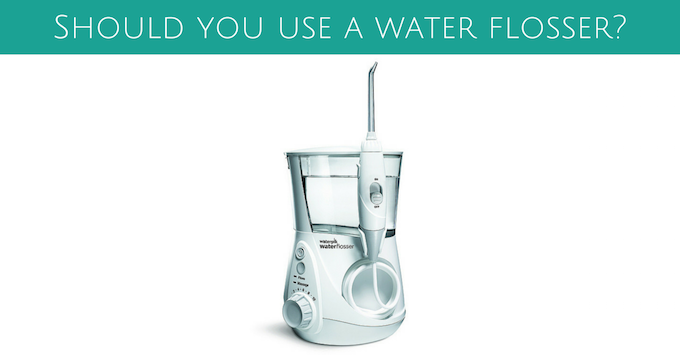What is a Water Flosser (And Should You Use One)?
Photo: SITS Girls
Do you find yourself forgetting to floss some days? You’re not alone. Just half of Americans floss daily, and 18.5% don’t floss at all.
Even if we don’t always remember to do it, flossing is an important part of our daily routine. Floss gets to places between your teeth and in the spaces between your teeth and gums your toothbrush can’t reach. But is dental floss your only option?
Some people swear by a device called a water flosser, and we recommend them to many of our patients. If you’re like a lot of people, you may have heard the term before but you’re not sure exactly what it is or how it works.
This post will give you the low down on water flossers and help you decide if it’s something you should try.
What Is a Water Flosser?
A water flosser, sometimes called a water pick, is an oral irrigator. That means it’s a cleaning device that shoots a thin stream of water, and when aimed between your teeth or at the gumline it can remove food particles and plaque on or between your teeth. The most popular version is made by Waterpik.
Photo: osseous
A water flosser needs to be plugged into an outlet and requires a reservoir of water. That means it’s not portable like floss, but it is gentle and easy to use.
Should You Try It?
It depends. If your regular brushing and flossing routine is working just fine for you, you probably don’t need a water flosser.
As a dentist, I can tell you that regular old dental floss works like a charm when used daily. In fact, standard floss is considered the most effective tool for cleaning between teeth.
So don’t use a water flosser as a substitute for regular brushing and flossing. You still need to use regular floss every day. If you get a water flosser, use it as a supplement to your traditional routine or to reach difficult-to-clean places.
Let’s look at a few situations where a water flosser might help you.
Your Gums Keep Bleeding
Do you keep seeing blood on your dental floss? There are a few common reasons why people’s gums bleed.
The first is gum disease. Gum disease, or periodontitis, means you have a bacterial infection in your gums. If it gets bad enough, it can eventually lead to tooth loss. You don’t want that! If you think you might have unhealthy gums, make an appointment with your dentist as soon as you can.
Flossing too hard can also cause bleeding gums. When you floss, you want to gently massage all areas between the teeth, including gums, but don’t scrape too hard or jam the floss too far up into your gum-line. The American Dental Association (ADA) has a helpful tutorial on how to floss properly if you want to make sure you’re doing it right.
If you have been diagnosed with gum disease by your dentist and have some hard to clean areas that continue to bleed despite good flossing, water flossers can be a great way to clean these problem areas. I often recommend water flossers to patients with a few areas of persistent gum inflammation, and in many cases the water flossers clean these areas well enough to see a noticeable reduction in inflammation and bleeding, which is the goal of treatment to address gum disease.
Try this: If you’re gums are sensitive, the last thing you want to do is stop using regular floss. But you can use a water flosser before you floss to gently remove as much food as possible. Then you’ll hopefully be able to get the rest out gently with dental floss.
You Have Braces
Water flossers are great for people with braces who tend to get more food particles stuck in their teeth. Not only does that feel gross and annoying, it increases your risk for cavities when you don’t clean them out.
Try this: If you’re at home, you can use your water flosser between meals, in addition to regular flossing.
Note: Your orthodontist may have inexpensive, manual oral irrigators that don’t need to be plugged in. They work really well and they’re portable. It’s worth asking before you invest in an electric water flosser.
You Have Dry Mouth
Certain medications and genetics can keep you from producing enough saliva. Saliva naturally cleans your mouth, and prevents sticky plaque from building up on teeth and gums. So dry mouth isn’t just uncomfortable, it can also lead to gum disease and cavities.
Try this: A water flosser is an easy way to add moisture to a dry mouth and help to remove sticky plaque due to dry mouth. It’s not a long-term solution, but it’s a good quick fix, and a good way to help remove plaque and food particles that aren’t washed away naturally by saliva.
If dry mouth is a problem for you, here are some more lasting solutions:
Look into special toothpastes and mouthwashes that help with dry mouth.
Get in the habit of drinking plenty of water throughout the day.
If your dry mouth is related to a medication, ask your doctor if there’s another option.
Schedule a dental checkup to talk to your dentist about other options. I’m happy to discuss it with you if you like!
Stuff Always Gets Stuck In Your Teeth
Some people just get more food stuck in their teeth than others. And it doesn’t mean you’re a messy eater! It probably has more to do with the shape of your teeth. People with small gaps where their teeth and gums meet are more likely to have that problem.
It can also happen when you’re teeth aren’t perfectly aligned. That’s usually due to genetics, and those rotated or crowded teeth can create pesky food traps.
Food can also get stuck around some dental work like bridges and dental implants, and water flossers can be a big help to clean these harder to reach places.
Try this: Use your water flosser right after regular floss, or whenever you feel like you need it.
How to Use a Water Flosser
If you’ve decided to give water flossing a try, here’s a quick video from WaterPik about how to use one:
I recommend starting on the gentlest setting. Many people say it feels a little weird at first, but you’ll get used to it. They also make versions that you can use in the shower, which helps to contain the water spray to a place where you don’t mind getting wet.
Final Thoughts
Water flossers, when used correctly, can be a great addition to your regular daily dental routine. The truth is, we don’t really know how effective they are at promoting long-term oral health when used instead of floss. We do know that regular floss works, though.
What’s the takeaway? If you think a water flosser might give you an additional benefit that regular floss can’t, give it a try. But use it with (not instead of) regular dental floss. If you start noticing pain or discomfort when you use your water flosser, stop using it and see your dentist to makes sure you don’t have another underlying problem.
Have concerns about flossing? Feeling like regular floss isn’t doing the trick? Get in touch, and we can discuss more advanced cleaning options.





